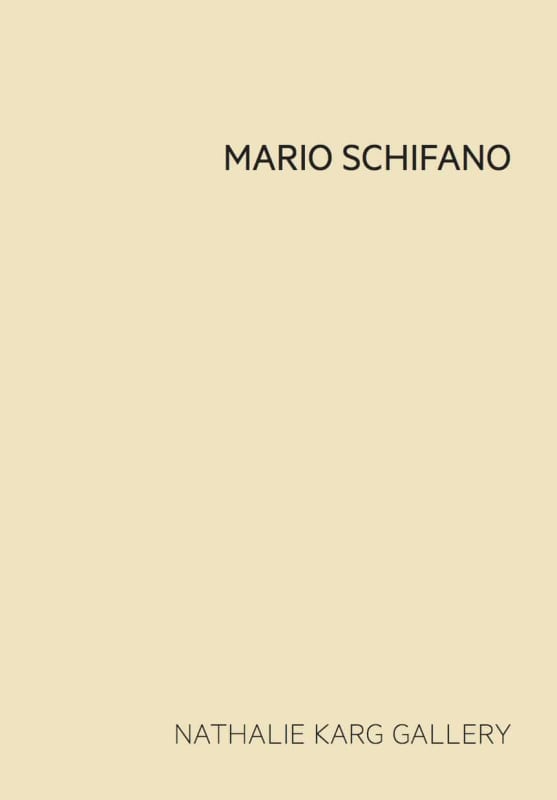Dimensions: 8 x 5 1/2 in
Pages: 20
Booklet produced in colllaboration with The Cult of Television Images (TV works from the 70s), 2019
Press Release
Nathalie Karg Gallery is pleased to present an exhibition of Mario Schifano’s Paesaggi TV’ (TV Landscapes) curated by Jennifer Bacon and Filippo Fossati. With his TV Landscapes, Mario Schifano created a cosmogony, a visual theory on painting that conveys his perception of our world and his instructions on how to make sense of it. In a world already complete, whole, making its own sense, he believed that the artist’s intervention was necessary for another reality to be revealed. He rebelled against the tendency of every society to create categories, systems, habits, rules and codes that often revolve around abstract aspects of human life that he felt can’t be simply categorized, organized, bureaucratized or institutionalized. Schifano disliked the idea of the “absolute order of things”. He feared that with the world being complete, full of numerable and contiguous material and in need of nothing, a painter in the early 70s could invent little. He viewed “conceptual artists” as merely making inventories, lists and catalogues.
Schifano responded with the Paesaggi TV, (TV Landscapes) in which he transferred television pictures onto canvas using the technique of photographic emulsion. At the beginning, he used photographs he took in the United States and later a myriad of images endlessly broadcasted on television stations everywhere. From the Vietnam war to The Great Masters of Art History television series to late night porn, the images were carefully selected, photographed and printed on canvas or on paper according to the series they belonged to (i.e., the Homages, featuring artists like Picasso, Cézanne and De Chirico, or the TV Landscapes). Subsequently Schifano created a closed-loop TV studio by connecting a video camera directly onto the TV screens which allowed him to record and broadcast at the same time. Each work from the broad TV series was then painted in psychedelic colors and set in a box made of plexiglass. The subjects were stopped in time, the fast and synthetic brushstrokes sometimes limited to a few drops of color. The result was a black canvas emitting a spark of actual television transmission, a hybrid of painting, photography, sculpture and television. The frame not only served the purpose of magnifying a detail of the world but represented his obsession, his desire for a place to belong too, his love for all means of physical and mental travels, for painting, for the moving image, for television. The screened image is not simply an accommodation, the representation of a box or a mere object, but a personal eye eager to travel, urging a departure, pulling viewers into the experience of a real poetic of exploration into known territories.
Mario Schifano was born in Homs, Libya, on September 20, 1934. His father was an archaeologist working there for the Minister of Education and returned with the family to Rome after the end of WWII. Schifano’s first exhibition at the Galleria Appia in Rome in 1959 displayed monochrome paintings which had the premonition of the screen, the frame that would later be filled with details of corporate logos such as Coca Cola and Esso. His paintings soon evolved to an energetic mix of drippy, messy, varying surfaces evoking the unprecedented experience of the new fast-paced, post-war world. Those paintings drew the attention of critic Pierre Restany who invited him to be part of the impactful group show “Five Roman Painters,” with Franco Angeli, Tano Festa, Francesco Lo Savio and Giuseppe Uncini at Galleria La Salita. Restany also introduced Schifano’s work at Sidney Janis’s gallery in 1962 in the famous show “The New Realists,” a seminal event including a new generation of artists at the beginning of their careers, such as Dine, Indiana, Lichtenstein, Oldenburg, Rosenquist, Segal, Thiebaud, Warhol and Wesselmann among others. Mario spent time in New York with Anita Pallenberg and became friends with many personalities of the New York scene like Frank O’Hara, Jasper Johns, Mark Rothko, Andy Warhol and Gregory Corso.
The works of the subsequent years show Schifano’s reformist ideas on painting which led him to mingle his favorite media with music, cinema, video, photography, and testify to his inquisitiveness vis-a vis technology and science. In 1971 he shot a movie titled “Umano non Umano” (“Human Not Human”) featuring celebrities such as Mick Jagger, Keith Richard, Carmelo Bene, Sandro Penna, Alberto Moravia and Rada Rassimov among others. In 1985 he painted a monumental canvas live in front of six thousands viewers in Piazza Santissima Annunziata in Florence which inaugurated a series of exhibition on the Etruscans. The same year, he married Monica and their son Marco was born. He continued an exceptional and glorious career as one of the most radical painters of post-war Italy, and as one of the most inspiring artists to new generations. During one of his trips to Brazil he created a happening in the favelas of Rio de Janeiro, by painting a shanty white in protest against the city mayor’s order to paint all the favelas green in order to standardize them and make them “invisible“. Even at the end of his life, when personal computers appeared, he immediately perceived the possibilities of the World Wide Web, which extended the expressive potential, access and speed of visual arts processes. His enthusiasm was such that he created a work entitled “Fibre-Ottiche” which became the symbol of the new mass media. In 1997 he participated in “Minimalia” at Palazzo Querini Dubois in Venice. He died in Rome on January 26, 1998.
The exhibition is made in collaboration with the Archivio Mario Schifano: www.marioschifano.it
